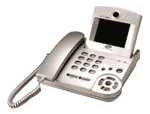 |
Video phoning is the communication tool of the future. The opportunity to speak, listen and see the caller onscreen is right out of a science fiction movie. With the current models available, the future is here. Situation: You’re here, they (friends, family, business associates, |
Videophones enable you to be (so to speak) in two or more places at the same
time-a phenomena that’s called "TelePresence." If you want to visit with family
or friends, conduct a professional consultation or communicate with business
associates anywhere in the world there’s plain old telephone service," says John
P. Monahan, president and CEO of Wind Currents Technology, "you can do it with
voice and picture." A videophone is basically a telephone with a 33.6 modem, a
processing chip, a color video, and a small LCD screen that transmits the video
at up to 15 frames per second with simultaneous audio. It’s plug-and-play, which
means you connect it to the phone jack and electrical power, turn it on, dial,
speak to your party, and initiate the video, provided the same or something
compatible is on the other end. No technical or computer skills are necessary.
When I called my son and his wife in Denver, up on the screen popped their
faces, side by side, little baby face smiling underneath the two adult heads. We
talked for a half an hour at regular phone rates and on two occasions they held
up photos of the addition to their house.
Up until now, the quality of videophone images was mediocre and the prices were
prohibitive, especially for small businesses and individuals. Times-and
prices-have certain changes. Back in 1970, AT&T introduced one of the first
videophones (at the New York World’s Fair) and offered subscribers basic (read
that: not very good quality) service for $160 a month plus $18 per minute
connection fees. PictureTel released a $20,000 black and white videophone in the
1980s and charged $30 an hour connection fees. With engineering success with
compression algorithms, set-top models and within reach prices started appearing
sometime in the early 1990s, but personal communication markets are only just
starting to develop, due to efforts of a handful of die-hard videophone
specialists.
Video phoning is the communication tool of the future. The opportunity to speak,
listen and see the caller onscreen is right out of a science fiction movie. With
the current models available, the future is here.
For further information, contact Wind Currents Technology (1718 M Street, NW,
No. 185, Washington DC 20036 / 202 723 3095, 800 893 9463 /
http://www.videophoneconnection.com
Gerber Gear 22-47162N Fast Draw Folding Assisted Opening Pocket Knife, Fine Edge, Black
$42.69 (as of December 17, 2025 18:17 GMT -05:00 - More infoProduct prices and availability are accurate as of the date/time indicated and are subject to change. Any price and availability information displayed on [relevant Amazon Site(s), as applicable] at the time of purchase will apply to the purchase of this product.)Gerber Gear EVO Jr. Folding Knife - Serrated Edge [22-41493]
$28.99 (as of December 18, 2025 13:53 GMT -05:00 - More infoProduct prices and availability are accurate as of the date/time indicated and are subject to change. Any price and availability information displayed on [relevant Amazon Site(s), as applicable] at the time of purchase will apply to the purchase of this product.)Product Information
| Price: | |
| Manufacturer: | N/A |


